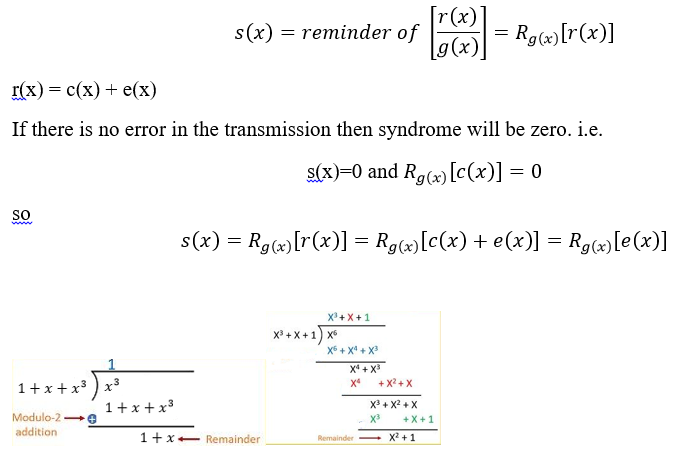Information Theory and Coding > Error Control Coding > Encoding and decoding the cyclic Code: Non-Systematic Encoding


Decoding
r(x) as received polynomial, c(x) as the encoded polynomial, g(x) to be generator polynomial, and e(x) as error polynomial.
The error involved during transmission, called Syndrome, its polynomial is calculated by

So if the obtained remainder is 0 then there will be no error and if the obtained remainder is not 0 then there will be an error that needs to be corrected on the basis of the amount of reminder. The following table is the list of reminder and error position and type. The Syndrome table is as follows:
|
Error Code |
Error Polynomial e(x) |
Error pattern S(x) |
|
1000000 |
1 |
1 |
|
0100000 |
x |
X |
|
0010000 |
X2 |
X2 |
|
0001000 |
X3 |
X+1 |
|
0000100 |
X4 |
X2+X |
|
0000010 |
X5 |
X2+X+1 |
|
0000001 |
X6 |
X2+1 |
Example:
Consider decoding when the codeword c=(1100101) belonging to the (7,4) code, incurs the error and received codeword is r=(1100111) and the generator polynomial is given g(x) = 1+ x + x3 . Find the codeword c=(1100101)
Solution:
Codeword c=(1100101) => polynomial that should be received c(x)= 1+x+x4+x6
Codeword received r=(1100111) and received polynomial is 1+x+x4+x5+x6
r(x) = c(x) + e(x)
Decoding:

From the syndrome polynomial table error polynomial is e(x) = x5 for s(x)=x2+x+1
r(x) = c(x) + e(x)
c(x)= r(x) - e(x) = 1+x+x4+x5+x6 - x5 = 1+x+x4+ x6
So the corrected codeword after decode = 1100101
Feedback
ABOUT
Statlearner
Statlearner STUDY
Statlearner